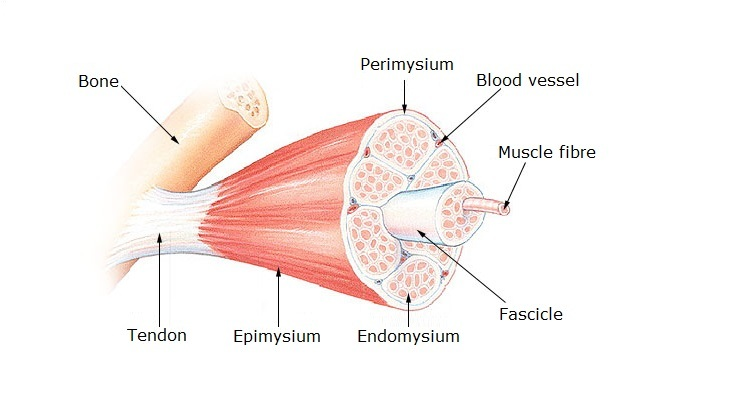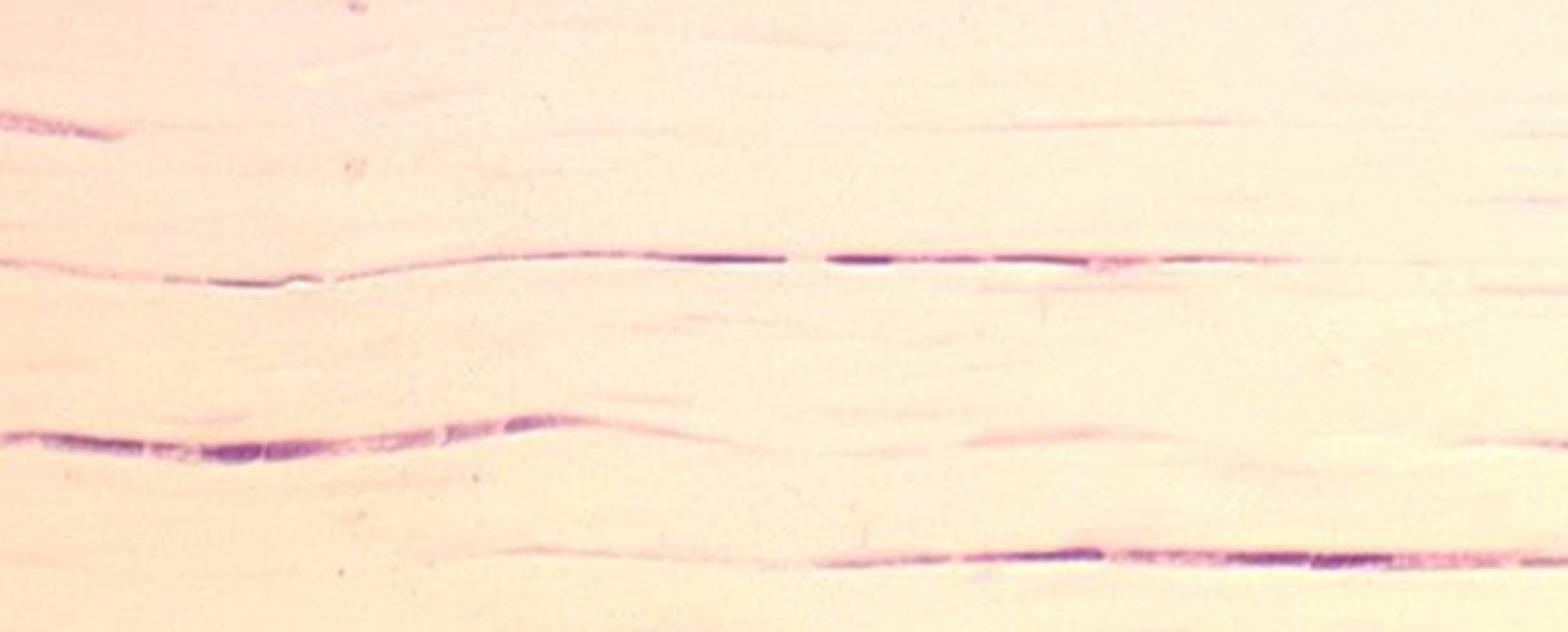1.6 muscle & tendon
Gross skeletal muscle anatomy
All muscle has primary muscle belly - most joins to bone via tendon, may sometimes join directly via Apennine process (which acts as bridge between muscle/bone or muscle/tendon)

tendon → epimysium → endomysium → perimysium → fascicle/sarcolemma → muscle fibre/cell
tendon
aponeurosis connects the muscle belly to tendon (which joins it all to bone)
may sometimes skip the tendon & connect straight to bone
endomysium
connective tissue surrounding the perimysium
epimysium
binds the muscle belly together
perimysium
collection of muscle fibres are found within perimysium
each fascicle is bound by perimysium (membrane)
muscle fibre
muscle fibre = muscle cell
packed with contractile proteins (myofibrils)
fascicle
surrounded by membrane (sarcolemma)
each muscle belly is comprised of fascicles
microstructure of skeletal muscle

Cardiac muscle
Striated
Single central nucleus
Involuntary
Irregular arrangement w/ intercalated disks
Located in heart
Smooth muscle
No striations
Single nucleus (nervous signal not required for all contractions within muscle)
Involuntary
Longer contractions
Located in e.g. walls of uterus, oesophagus, bronchi, arteries
Roles of muscle
Continence
Mastication
Swallowing
Digestion
Birthing
Vaso-dilation/constriction
Bronchodilation/constriction
Pupil dilation/constriction
Maintaining cardiac rhythm
Joint movement
Prevent joint movement (joint stabilisation)
Postural control
Generating heat (shivering)
tendons during locomotion
Muscle = proximal
Tendon = distal
Most muscles associated w/ some kind of tendon
Proximal tendons tend to be shorter & fatter
Distal tendons tend to be longer
having longer tendons means you can have shorter muscle fibres (long tendons are usually coupled w/ pennate muscles)
short muscle fibres don’t shorten (contract very much) - reducing energy cost of developing muscle force
tendon structure:
hierarchy: fascicles → sub-fascicle → collagen fibre → collagen fibrils
tenocytes → formation & turnover of the ECM

Roles of tendons:
Minimising distal limb mass (e.g. horse)
Joins muscle to bone (transmits muscle force to skeleton)
Elastic energy storage
legs behave like pogo sticks, tendons act to store & release elastic potential energy (animals with long tendons are more economical)
Act to store & release elastic energy, thus reducing cost of running at steady speed
Animals w/ long substantial organs are therefore economical - expend little energy when running
Energy conservation
Long tendons = short muscle fibres
Tendons can stretch/shorten ~10% during galloping
Short muscle fibres don’t shorten (contract) v much, reducing energy cost of developing muscle force
Some muscles have v short muscle fibres so they look vestigial - interosseus; SDF & DDF in horse
Power amplification
Muscles shorten to perform work - doing this quickly = power
muscles generate power, tendons store power as they stretch
POWER = RATE OF DOING WORK
Stretched tendons recoil faster than muscle shortens = more power
Only small amount of work done but in shorter time, so output is higher
E.g. horses require >2000W power to swing legs quickly during fast gallop, 50kg muscle needed for active protraction
Muscle design
Size, shape (long/thin vs short/fat), number of bellies (biceps/triceps), tendinous origins or insertions, architecture
Architecture - arrangement of muscle fibres (relative to axis of force generation)
Encompasses - muscle volume, muscle moment arms, tendons
Muscle function - in terms of force, work & power
Force - push/pull on an object w. mass, causing it to change velocity
Work = force x distance
Power = Δwork/Δtime (rate of performing work)
Muscle fibre arrangement
Pennate muscles
Short fibres at angle to internal tendon/aponeurosis
Increases muscle physiological cross sectional area (PCSA) - muscle force is proportional to this
Shorter fibres = shorter distance to contract = economical
packs more muscle in smaller area
shorter contraction distance → less energy used to generate same movement
E.g. serratus ventralis (attaches scapula to ribcage → synsarcosis)

Parallel muscles
Fibres run in parallel to line of pull of muscle
found where where a limb needs movement
More sarcomeres in series = greater total muscle fibre shortening = more potential for performing muscle work
Work = force x distance
Muscles can move joints through large range of motion
Potential for increased velocity of contraction (since speed = distance/time)
e.g. proximal forelimb or hamstring

 Knowt
Knowt